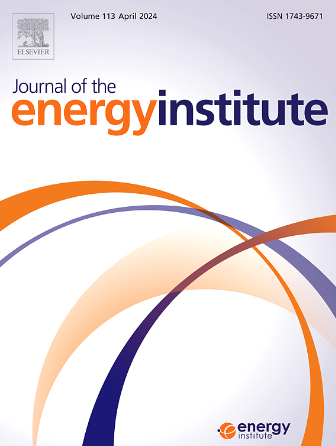Experimental study of ammonia energy ratio on combustion and emissions from ammonia-gasoline dual-fuel engine at various load conditions
IF 5.6
2区 工程技术
Q2 ENERGY & FUELS
引用次数: 0
Abstract
Achieving carbon neutrality necessitates the adoption of zero-carbon fuels in engine applications, with ammonia emerging as an up-and-coming candidate due to its favorable safety profile and advantages in storage and transportation. This study experimentally investigated the feasibility of an ammonia-gasoline dual-fuel (AGDF) engine to achieve comparable power output and satisfactory carbon reduction without changing the main structural parameters of the engine. A four-cylinder, naturally aspirated, spark ignition engine was used to investigate the impact of ammonia energy ratio (AER), engine base torque and engine speed on the engine performance, combustion evolution and emission characteristics. The findings reveal that the brake thermal efficiency (BTE) in AGDF mode is lower than in gasoline-only mode, primarily due to the reduced combustion activity. However, this efficiency decline becomes noticeable only when the AER exceeds 15 %. Additionally, at high AERs and high engine base torques, the delayed effect of ammonia fuel on the main combustion period results in a double-peak pattern, which limits the energy output but presents opportunities for phase optimization. The study also examined three incomplete combustion emissions, each exhibiting distinct behaviors. Except for ammonia slip, adding ammonia fuel does not significantly affect carbon monoxide (CO) and unburned hydrocarbons (UHC) emissions, particularly at AERs below 25 %. Nevertheless, nitrogen oxide (NOx) emissions under AGDF combustion are significantly higher than under gasoline alone in most instances. Crucially, the study demonstrates the carbon reduction potential of ammonia fuel across different engine loads, with a maximum carbon dioxide (CO2) reduction of 46.8 % at a 35 % AER. It is anticipated that further optimization of the combustion phase will improve the capability for carbon reduction.
不同负荷条件下氨能比对氨汽油双燃料发动机燃烧和排放的实验研究
要实现碳中和,就必须在发动机应用中采用零碳燃料,而氨因其良好的安全性能以及在储存和运输方面的优势,正在成为一种新兴的候选燃料。本研究通过实验研究了氨气-汽油双燃料(AGDF)发动机的可行性,在不改变发动机主要结构参数的情况下,实现了相当的功率输出和令人满意的碳减排效果。研究人员使用一台四缸自然吸气火花点火发动机,研究了氨能比(AER)、发动机基础扭矩和发动机转速对发动机性能、燃烧演化和排放特性的影响。研究结果表明,在 AGDF 模式下,制动热效率(BTE)低于纯汽油模式,主要原因是燃烧活性降低。然而,只有当空燃比超过 15% 时,这种效率下降才会变得明显。此外,在高空燃比和高发动机基础扭矩条件下,氨燃料对主燃烧期的延迟效应会导致双峰模式,这限制了能量输出,但为相位优化提供了机会。研究还考察了三种不完全燃烧排放,每种排放都表现出不同的行为。除氨滑移外,添加氨燃料不会明显影响一氧化碳(CO)和未燃碳氢化合物(UHC)的排放,特别是在 AER 低于 25% 时。然而,在大多数情况下,AGDF 燃烧时的氮氧化物(NOx)排放量明显高于单独使用汽油时的排放量。最重要的是,该研究证明了氨燃料在不同发动机负荷下的碳减排潜力,在 35% 的空气氧化率条件下,二氧化碳(CO2)的最大减排量为 46.8%。预计燃烧阶段的进一步优化将提高碳减排能力。
本文章由计算机程序翻译,如有差异,请以英文原文为准。
求助全文
约1分钟内获得全文
求助全文
来源期刊

Journal of The Energy Institute
工程技术-能源与燃料
CiteScore
10.60
自引率
5.30%
发文量
166
审稿时长
16 days
期刊介绍:
The Journal of the Energy Institute provides peer reviewed coverage of original high quality research on energy, engineering and technology.The coverage is broad and the main areas of interest include:
Combustion engineering and associated technologies; process heating; power generation; engines and propulsion; emissions and environmental pollution control; clean coal technologies; carbon abatement technologies
Emissions and environmental pollution control; safety and hazards;
Clean coal technologies; carbon abatement technologies, including carbon capture and storage, CCS;
Petroleum engineering and fuel quality, including storage and transport
Alternative energy sources; biomass utilisation and biomass conversion technologies; energy from waste, incineration and recycling
Energy conversion, energy recovery and energy efficiency; space heating, fuel cells, heat pumps and cooling systems
Energy storage
The journal''s coverage reflects changes in energy technology that result from the transition to more efficient energy production and end use together with reduced carbon emission.
 求助内容:
求助内容: 应助结果提醒方式:
应助结果提醒方式:


